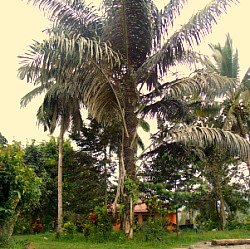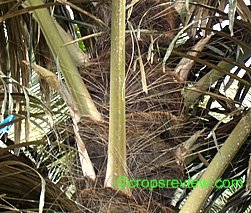Kaong or sweet palm is a promising cash crop with potential for the establishment of plantations or, at the least, for deliberate growing to supplement the natural stands.
It has been noted that the worldwide demand for the processed products of this palm continues to grow, but the supply of raw materials is limited by the number and accessibility of natural stands.
These natural sources are dispersed.
Botanical Description

Kaong is a monoecious solitary palm.
The trunk is up to 15-20 m with a diameter of about 30-40 cm.
Leaves are pinnate, up to 8.5 m long. Leaf-sheaths with fibrous black hairs cover the stem.
Axillary inflorescences arise singly first from the top and continue downward until the palm dies.
Fruits turn yellow at maturity, having a diameter of about 5 cm. Each fruit has 2-3 seeds. (ICRAF, undated).
This palm first flowers when around 10-12 years old; however, sometimes it flowers as early as 5-6 years.
Maturity is indicated by the simultaneous appearance of 2 short leaves at the top of the stem.
The average flowering period of an untapped tree is 4-6 years according to ICRAF (undated).
On the other hand, Florido and De Mesa (2003) presented a report that flowering starts at 12 to 16 years depending on the elevation.

Geographical Distribution, Soil, and Climatic Adaptation
Kaong grows wild from India through Malaysia to the Philippines.
Its exact origin is unknown, but it may be from the region of Minahassa in North Lulawesi, Indonesia because there is abundant growth of this palm plant in this area.
It is adapted to elevations between sea level and 1,400 meters.
It grows wild in primary or secondary forests, especially on sites poor in nutrients and in denuded hillsides.
It is found naturally growing in the Phillippines, often along river banks from low to middle elevations.
It is estimated that there are about 4.67 million kaong palms in its dipteroarp forests (Neri, undated).
Its fruits are scattered by wild hogs, fruit bats, and civet cats.
Why Kaong?
Also called gomuti and sweet palm (Arenga pinnata), this plant has multiple uses. Practically all parts, from root to apex, are useful.
In the Philippines, its major product is sweetened, cooked meat (endosperm) from young fruits.
The average number of fruits per inflorescence is 480. Every tree produces 5,000 to 7,000 seeds.
The average flowering period of an untapped tree is 4-6 years (ICRAF, undated).
Another product is the sweet sap (toddy, tuba, saguer) which is obtained by tapping the male inflorescences.
An inflorescence can be tapped for 1-2 1/2 months, producing about 5-12 liters of sap per day.
This sap can be used as a beverage or processed into vinegar, sugar, alcohol, or animal feed.
Sugar yields maybe about 70 kg/day per ha or 25 t/ha per year.
Black fiber, called gomuti, yumot, cabonegro, and ijuk, can also be collected from the bases of petioles of mature palms.
This fiber is used in the manufacture of sea water-resistant rope, brushes, and other materials.
As early as 1821, it was reported that 439,450 sugar palms were harvested for the fiber in Indonesia, yielding as much as 300,000 ropes from a single factory in one month.
When the palm trees are more than 30 years old or about to die, they are cut down for sago, the starchy layer on the inner part of the trunk.
Sago yields may be up to 100-150 kg/tree.
Constraints
The major constraints in the commercialized growing of kaong are the following:
(1) long juvenile (vegetative) phase of growth (10-16 years from planting, but there are reports of 5-6 years);
(2) short productive phase (the exact duration is uncertain but the reported maximum age at cutting for sago is above 30 years from planting);
and (3) lack of reliable information on the production and profitability of the crop.
Why Still Grow?
It’s called “gut feeling.” It’s about supply and demand.
When supply is low but demand is high, the price is high. There is profit, therefore, for the first to control the supply.
The products from kaong and their processing methods are known to the traditional farmers and so a farmer has the option to market his produce raw or processed.
As to the adaptation of the crop, it is known to thrive in the harsh climates and poor soils. It is also resistant to insect pests and diseases
It can be easily favored by marginal farmers.
If it can grow by itself in the wild, then it can grow better under domestication.
As for the cultural requirements, the basics of crop farming apply to all crops.
Details, like the distance of planting, can be obtained from similar plants like coconut.
The botany of the crop and actual observation of a live specimen will also give revealing information on its management.
The experience to be yet acquired and personal experimentation will do the rest.
In far-flung barangays where kaong fruits are harvested from natural stands, wide portions of farms are still underutilized.
The farmers only need to be made aware of the potentials of this crop and be given technical and marketing assistance.
Essentially, the only question that needs to be answered is “how much will I surely earn?”
On the long juvenility and short life span of the crop, this will not matter so much in farms that are underutilized.
What will matter much are market price and stability.
In Indonesia, the short life span fitted well into the practiced rotation cycles of shifting cultivation which is usually between 12 and 15 years in traditional systems.
Update: It’s not a mere gut feeling anymore.
On several occasions, the herein author was contacted by electronic means and in person asking for assistance in looking for supplies of semi-processed kaong meat.
The Department of Trade and Industry conducted a seminar on the crop’s propagation and farm establishment with him as a resource person.
Continue reading:
Propagation Methods / Sweet Palm Seed Propagation
REFERENCES
Ecocrop. undated. View crop: Arenga pinnata. Retrieved August 27, 2010 from http://ecocrop.fao.org/ecocrop/srv/en cropView?id=3348.
Florido, H.B. and De Mesa. 2003. Sugar palm (Arenga pinnata (Wurmb.) Merr. Research Information Series on Ecosystems (RISE). Vol. 15 No. 2. Retrieved August 26, 2010, from http://erdb.denr.gov.ph/publications/rise/r_v15n2.pdf.
International Center for Research in Agroforestry (ICRAF). undated. Species information: Arenga pinnata. Retrieved August 26, 2010 from http://www.worldagroforestry.org/sea/Products/AFDbases/af/as p/SpeciesInfo.asp?SpID=119.
Neri, B. undated. Non-wood forest products in Asia- Philippines. Retrieved August 27, 2010, from http://www.fao.org/docrep/x5334e/x5334e09.htm.
